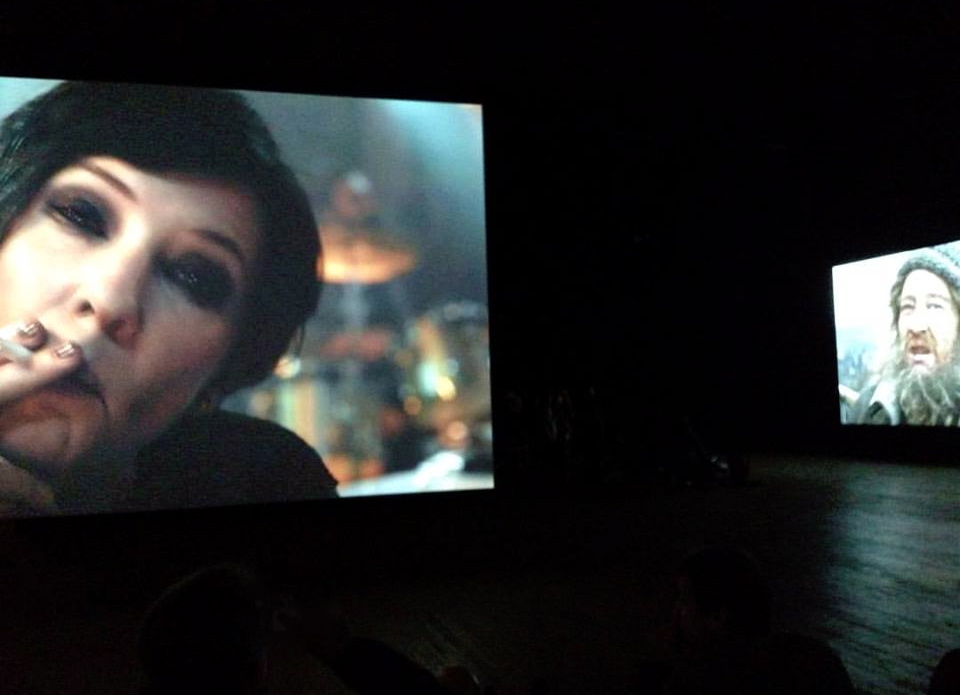MANIFESTO is an installation by Julian Rosefeldt of 13 short films in simultaneous play in the darkened space of the Park Avenue Armory. More than one, but never all, of the screens are visible from a given point. Cate Blanchett, playing different roles in each film, delivers lines taken from some 55 manifestos (most artistic, but a couple political). Once every 11 minutes her face appears in close-up throughout the room. It takes a good two hours to experience the exhibit fully, to, that is, watch each film individually while also taking in the spatial, visual and auditory effects of the whole environment.
The manifestos sound remarkably alike if heard in snatches. A casual walk-through favors hearing over seeing and mushes the sense of them together. There is, in fact, a lot of overlap. Some is rhetorical: each calls a form or movement into being by declaration. Some is structural: the wrongs of the old are rejoined by how the new will put them right. They share an attitude: proceeding by assertion rather than argument, they are almost inherently absolutist. There’s also a similarity in what they are rebelling against, even if, sometimes, it is against each other. Each is 20th-century, excepting one from 2002 (by filmmaker Jim Jarmusch) and another (the most famous of all) from 1848. So they all, in a sense, oppose or embrace some aspect of modernity, of which the manifesto is, ironically, a distinctive feature.
Of no form is it truer that context creates meaning than the manifesto, which excoriates something to replace it with something else. But MANIFESTO is not a history lesson. It doesn’t rehearse the original circumstances of the manifestos, whether Zurich between the wars (Dada) or the late century cinema that Dogma 95 opposed. Instead, they are radically re-contextualized to the present, usually to some situation in which a single speaker dominates: saying grace at a meal, delivering a eulogy, conducting a class, anchoring the news, the rant of a street person, choreographing a show. Placing them in contexts palpably unaffected by the changes they demanded calls out the idea that change, even if achieved, can be permanent or even stable.
Blanchett’s protean performance in 13 roles (plus neutral voiceovers) is, beyond the exhibit’s intellectual rewards, reason enough to go. She enters with deadpan perfection into the realities upon which the manifestos are superimposed. Praying before dinner, as a Southern-accented “conservative mother with family”, she doesn’t miss a beat when the words she is speaking – Claes Oldenburg’s on Pop Art – grow off-color and scatological (the family’s reactions are wonderful, especially the bored kids who giggle at the bad words). She’s an embodiment, as both “newsreader” and “reporter” (interviewing herself) of the fakeness and artificiality critiqued by the proclamations of Minimalism and Conceptual Art that make up the broadcast. She’s a cool CEO spouting the precepts of Vorticism, Blue Rider and Abstract Expressionism like corporate platitudes at a house party; a master of brusque didacticism as a teacher declaiming the wisdom of Stan Brakhage, Jarmusch, Werner Herzog and other film visionaries as though they were exam instructions for school kids; a bearded homeless man expounding on Situationism through a blow horn; a martinet of a choreographer berating her dancers with the words of Fluxus.
In those roles and more Blanchett is virtuoso in her transformations; the givens of circumstance are sunk in her to the bone. When the simultaneous close-up occurs, she switches to a different mode in each role, incanting the words like a cultist, acolyte, or automaton. To hear her in unison is cautionary, for it exposes a dangerous irony in some if not all manifestos: they object to conformity and demand that all of us do so. This is a counterpoint, of sorts, to the installation’s larger point. Manifestos dramatize, as a form, that there will always be someone who objects to what is and call for its overthrow; they contain, as such, the seeds of their own destruction. Maybe, though, it would be wise not to rely on that, but to find a way, somehow, to demand change without conformity, or at least build into it the knowledge that it need not be universal and will exist only for a time.
MANIFESTO was installed through Jan. 8, 2017, at the Park Avenue Armory: info. A theatrical showing at Film Forum is scheduled through June 27: info.
